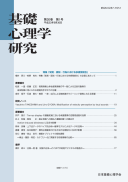Volume 8, Issue 2
Displaying 1-12 of 12 articles from this issue
- |<
- <
- 1
- >
- >|
-
Article type: Cover
1990 Volume 8 Issue 2 Pages Cover5-
Published: March 31, 1990
Released on J-STAGE: November 11, 2016
Download PDF (27K) -
Article type: Cover
1990 Volume 8 Issue 2 Pages Cover7-
Published: March 31, 1990
Released on J-STAGE: November 11, 2016
Download PDF (52K) -
Article type: Article
1990 Volume 8 Issue 2 Pages 57-59
Published: March 31, 1990
Released on J-STAGE: November 11, 2016
Download PDF (451K) -
Article type: Article
1990 Volume 8 Issue 2 Pages 61-68
Published: March 31, 1990
Released on J-STAGE: November 11, 2016
Download PDF (1009K) -
Article type: Article
1990 Volume 8 Issue 2 Pages 69-82
Published: March 31, 1990
Released on J-STAGE: November 11, 2016
Download PDF (1714K) -
Article type: Article
1990 Volume 8 Issue 2 Pages 83-94
Published: March 31, 1990
Released on J-STAGE: November 11, 2016
Download PDF (1577K) -
Article type: Article
1990 Volume 8 Issue 2 Pages 95-100
Published: March 31, 1990
Released on J-STAGE: November 11, 2016
Download PDF (691K) -
Article type: Article
1990 Volume 8 Issue 2 Pages 101-102
Published: March 31, 1990
Released on J-STAGE: November 11, 2016
Download PDF (325K) -
Article type: Article
1990 Volume 8 Issue 2 Pages 102-
Published: March 31, 1990
Released on J-STAGE: November 11, 2016
Download PDF (198K) -
Article type: Article
1990 Volume 8 Issue 2 Pages 102-
Published: March 31, 1990
Released on J-STAGE: November 11, 2016
Download PDF (198K) -
Article type: Article
1990 Volume 8 Issue 2 Pages 102-
Published: March 31, 1990
Released on J-STAGE: November 11, 2016
Download PDF (198K) -
Article type: Article
1990 Volume 8 Issue 2 Pages 103-
Published: March 31, 1990
Released on J-STAGE: November 11, 2016
Download PDF (202K)
- |<
- <
- 1
- >
- >|
